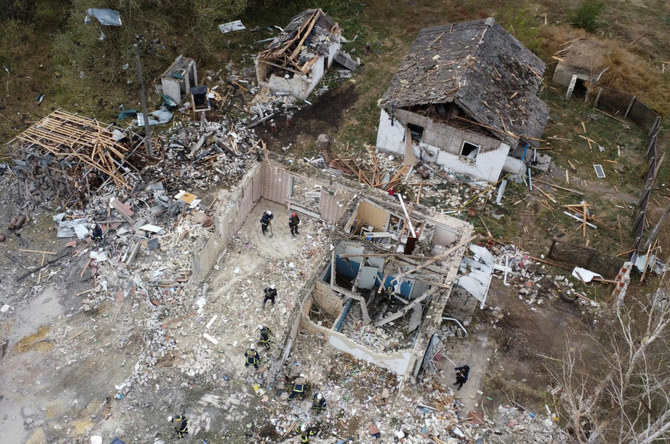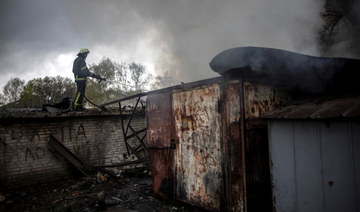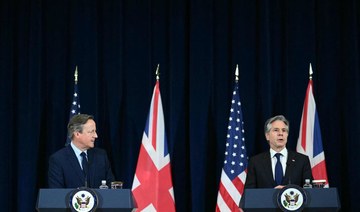KHARKIV, Ukraine: A 10-year-old and his grandmother were killed on Friday when Russian missiles smashed into Kharkiv in eastern Ukraine, just hours after another attack left dozens dead at a wake in a nearby village.
Rescue workers in Kharkiv were extinguishing fires next to charred vehicles, and twisted missile fragments lay in a deep crater in the center of the city, an AFP journalist at the scene said.
Multiple-story buildings surrounding the debris-strewn blast site were scarred by the impact of two cruise missiles, with dozens of windows blown out. Dazed residents walked beneath the skeletal housing blocks.
President Volodymyr Zelensky said the attack had killed a 10-year-old boy and described the strikes as another example of “Russian terror” in a statement offering condolences to the child’s family.
Kharkiv regional governor Oleg Synegubov said later that municipal workers had retrieved another body.
“Rescue workers found the body of a 68-year-old woman — the grandmother of the killed 10-year-old boy and his injured 11-month-old brother,” he said.
Another 28 people had been wounded, he added.
In an earlier statement, Synegubov described how two Russian missiles had landed in the city. One hit a road in the center of the city; the other slammed into a three-story building, causing a fire that sent plumes of black smoke into the sky.
Kharkiv, Ukraine’s second-largest city that lies in a region bordering Russia, has been under persistent Russian shelling since Moscow’s forces invaded in February last year.
The strikes there came as Synegubov updated the death toll from Thursday’s missile strike on a village in the Kharkiv region that had killed dozens of people less than 24 hours earlier.
“Fifty-two people have died as a result of this missile attack because one more person died in a medical facility,” Synegubov told state-run television, raising the toll by one.
The Kremlin, responding to questions from reporters on the village strike, again insisted that Russian forces do not target civilians in Ukraine.
“Strikes are carried out on military targets, on places where military personnel are concentrated,” Kremlin spokesman Dmitry Peskov told journalists.
Those killed in the village of Groza had gathered at a cafe for the wake for a fallen Ukrainian soldier.
The strike provoked outrage from Western leaders while the United Nations said the attack could amount to war crime.
The soldier being commemorated was killed a month after Russia invaded in February last year. He had been buried in the central city of Dnipro — away from his home village, which was then under Russian occupation.
He was reburied in Groza on Thursday morning. His wife and son, also a soldier, were both killed in the strike, officials said.
Around 20 rescuers from Kharkiv city were cleaning the rubble from the destroyed cafe and nearby shop on Friday morning.
Oleksiy and some of his family came to the cemetery to mark out graves for his sister and brother-in-law killed in the attack — their bodies had been taken by police to Kharkiv.
“I don’t know when we will be able to bury them,” he told AFP. “My brother’s body was preserved, but his wife’s head was missing.”
Nearby in the cemetery, a recently dug grave was covered with fresh flowers and a Ukrainian flag. It was the grave of 49-year-old Andriy Kozir, the soldier that villagers had gathered to pay hommage to when a missile hit their cafe.
“Everyone at the wake died,” said 73-year-old Valentyna Koziyenko, who lived opposite the destroyed cafe.
“The strike happened just after people went in,” she told AFP, adding that the blast from the strike had torn the roof off her building.
“How did the Russians know that so many people were in there?” said Koziyenko. “Maybe someone told them.”
Ukrainian Foreign Minister Dmytro Kuleba on Friday described the Kharkiv attacks as “atrocities” that “prove that global support for Ukraine must be sustained and increased.”
Swathes of the Kharkiv region were captured by Russian forces in the early days of their invasion, launched in late February 2022.
Ukrainian forces clawed back much of that territory in a lightning offensive late last year.
Deadly new strike as Ukraine mourns dozens killed at wake
https://arab.news/8rxry
Deadly new strike as Ukraine mourns dozens killed at wake

- Multiple-story buildings surrounding the debris-strewn blast site were scarred by the impact of two cruise missiles
- President Volodymyr Zelensky said the attack had killed a 10-year-old boy and described the strikes as another example of “Russian terror”
UK investigating Hamas’ claim that British hostage killed in Gaza

- Foreign secretary confirms viewing video
LONDON: The UK’s Foreign Office said on Sunday it was investigating a claim by Hamas that a British-Israeli hostage in Gaza had died from injuries sustained in an Israeli airstrike over a month ago.
Nadav Popplewell, 51, was captured along with his mother Channah Peri on Oct. 7 during a border incursion when the Palestinian group launched a surprise attack on Israel.
The Foreign Office said it was actively seeking more information on the matter.
Popplewell’s family has requested media outlets refrain from airing footage released by Hamas, showing him in captivity with visible injuries, the BBC reported.
The UK’s Foreign Secretary David Cameron, speaking to the BBC’s Laura Kuenssberg, confirmed viewing the video but provided no further updates on the investigation.
Cameron said: “We don’t want to say anything until we have better information.”
He described Hamas as “callous” for releasing the video and playing “with the family’s emotions in that way.”
The Foreign Office added that the department’s thoughts “are with his family at this extremely distressing time.”
The Israeli military has not issued a statement on the matter.
Israel’s military campaign in Gaza to destroy Hamas has killed over 34,900 people, the majority of whom are women and children, according to the Gaza Health Ministry.
Israel has reported that 128 hostages are unaccounted for.
UK mountaineer logs most Everest climbs by a foreigner, Nepali makes 29th ascent

- Both climbers used Southeast Ridge route to summit
- They were on separate expeditions guiding their clients
KATMANDU: A British climber and a Nepali guide have broken their own records for most climbs of Mount Everest, the world’s highest mountain, hiking officials said on Sunday.
Rakesh Gurung, director of Nepal’s Department of Tourism, said Britain’s Kenton Cool, 50, and Nepali guide Kami Rita Sherpa, 54, climbed the 8,849-meter (29,032 foot) peak for the 18th and 29th time, respectively.
They were on separate expeditions guiding their clients.
“He just keeps going and going... amazing guy!” Garrett Madison of the US-based expedition organizing company Madison Mountaineering said of the Nepali climber. Madison had teamed up with Kami Rita to climb the summits of Everest, Lhotse, and K2 in 2014.
K2, located in Pakistan, is the world’s second-highest mountain and Lhotse in Nepal is the fourth-tallest.
Lukas Furtenbach of the Austrian expedition operator Furtenbach Adventures called Cool’s feat remarkable.
“He is a fundamental part of the Everest guiding industry. Kenton Cool is an institution,” Furtenbach, who is leading an expedition from the Chinese side of Everest, told Reuters.
Both climbers used the Southeast Ridge route to the summit.
Pioneered by the first summiteers, New Zealander Sir Edmund Hillary and Sherpa Tenzing Norgay in 1953, the route remains the most popular path to the Everest summit.
Kami Rita first climbed Everest in 1994 and has done so almost every year since, except for three years when authorities closed the mountain for various reasons.
He climbed the mountain twice last year.
Mountain climbing is a major tourism activity and a source of income as well as employment for Nepal, home to eight of the world’s 14 tallest peaks, including Everest.
Nepal has issued 414 permits, each costing $11,000 to climbers for the climbing season that ends this month.
Banning UK arms exports to Israel would strengthen Hamas, UK’s Cameron says

- Cameron said he did not support an operation in Rafah in the absence of a plan to protect hundreds of thousands of civilians
LONDON: Stopping British arms sales to Israel if it launches a ground assault on Rafah in the Gaza Strip would strengthen Hamas, Britain’s Foreign Secretary David Cameron said on Sunday.
Israel ordered Palestinians to evacuate more of the southern city on Saturday in an indication it was pressing ahead with its plans for a ground attack, despite US President Joe Biden’s threat to withhold the supply of some weapons if it did so.
Cameron said he did not support an operation in Rafah in the absence of a plan to protect hundreds of thousands of civilians sheltering in the southern border city.
However, Britain was in a “completely different position” to the United States in terms of providing arms to Israel, he said, noting that the less than 1 percent of Israel’s weapons that came from Britain were already controlled by a strict licensing system.
“We could, if we chose to, make a sort of political message and say we are going to take that political step,” he told the BBC’s Laura Kuenssberg.
“The last time I was urged to do that (...), just a few days later there was a brutal attack by Iran on Israel, including 140 cruise missiles,” he added.
Cameron said the “better answer” would be for Hamas, which controls Gaza, to accept a hostage deal.
“Just to simply announce today we’re going to change our whole approach to arms exports rather than go through our careful process, it would strengthen Hamas, it would make a hostage deal less likely, I don’t think it would be the right approach,” he said.
Hamas attacked southern Israel on Oct. 7, killing some 1,200 people and taking more than 250 people hostage, according to Israeli tallies.
Israel’s military response in Gaza has killed close to 35,000 Palestinians, according to Gaza’s health ministry.
‘Completely helpless’: Afghanistan’s north struggles to get aid after deadly floods

- Thousands of houses and livestock were also wiped out by the flash floods
- Afghanistan is prone to natural disasters, considered vulnerable to climate change
KABUL: Survivors of the deadly flash floods that ripped through northern Afghanistan were still struggling without basic aid on Sunday, as the official death toll rose to over 300.
Heavy rains on Friday triggered flash floods across at least seven provinces, including Baghlan, Ghor, Badakhshan and Takhar, injuring more than 1,600 people and destroyed about 2,600 houses, according to the latest data from Afghanistan’s Ministry of Refugees.
Many people remain missing and livestock were wiped out as survivors picked through muddy, debris-littered streets and damaged buildings over the weekend, while authorities and humanitarian agencies deployed aid and rescue workers.
“All available resources are being mobilized, and relevant ministries and agencies are actively engaged in delivering urgent aid,” Mullah Abdul Ghani Baradar Akhund, Afghanistan’s deputy minister for economic affairs, told survivors in Baghlan province on Sunday, as he reassured “unwavering support” from the Taliban-led government “until their lives are restored to normalcy.”
But some people in the province, which bore the brunt of the deluges, said that aid has yet to reach them.
“We haven’t received any support from the government or aid organizations yet. Everyone comes and asks us questions, then they go back,” Ghulam Nabi, who is from the province’s Burka district, told Arab News in a phone interview.
“We lost our houses and our lives. Everything we had is under mud now. The agriculture land and livestock, our only source of livelihood, are also completely destroyed. We don’t have the basic means to cook food for ourselves.”
Since mid-April, flash flooding and other floods had left scores of people dead and destroyed farmlands across Afghanistan, a country where 80 percent of its more than 41 million people depend on agriculture to survive.
The South Asian nation is prone to natural disasters and is considered by the UN to be one of countries most vulnerable to climate change.
Aid group Save the Children said about 600,000 people, half of them children, live in the five districts in Baghlan that have been severely impacted by the recent floods.
“Lives and livelihoods have been washed away. The flash floods tore through villages, sweeping away homes and killing livestock. Children have lost everything,” Arshad Malik, the group’s country director in Afghanistan, said in a statement.
Most of the affected areas are still cut off on Sunday, inaccessible by trucks as roads and bridges were damaged by the floods, which also impacted other public infrastructure.
People were struggling to access essential health services, the World Health Organization said in a statement, as “several health facilities remain non-operational.”
Abdul Fatah Jawad, director of Ehsas Welfare and Social Services Organization, said that many of the flood survivors were still in shock.
“People are so scared and traumatized. Most houses that survived the flooding are emptied as people fear more floods. Families took refuge in school yards and deserted areas far from residential houses,” Jawad told Arab News.
He said families are in urgent need of basic goods, such as food, drinking water, medicine, tents, blankets and shelter. Since Saturday, his organization has managed to deliver cooked food for hundreds of families.
“People, particularly children, need to eat something … They also need cash to rebuild their houses and their businesses,” he said. “Some families lost everything — house, land, livestock, business. They are completely helpless.”
Indonesia welcomes expanded Makkah Route access as pilgrims start departing for Hajj

- Indonesia will be sending 241,000 pilgrims this pilgrimage season
- The Makkah Route initiative is available in 3 Indonesian cities
JAKARTA: Indonesia on Sunday welcomed the expansion of the Makkah Route initiative to three airports, as the first batch of the country’s largest Hajj contingent to date departed for Saudi Arabia.
The world’s biggest Muslim-majority nation will be sending 241,000 pilgrims to Saudi Arabia this year for the spiritual journey that is one of the five pillars of Islam.
Although the Hajj this year is expected to start on June 14 and end on June 19, many pilgrims depart early to make the most of the once-in-a-lifetime opportunity to fulfill their religious duty.
As Indonesia’s first Hajj flight carrying nearly 400 pilgrims departed from Soekarno-Hatta International Airport in the early hours of Sunday, Religious Affairs Minister Yaqut Cholil Qoumas said he was grateful to the Saudi leadership for adding the Makkah Route initiative in other Indonesian cities.
“On behalf of the Indonesian government, I thank the Saudi government for providing additional fast-track facilities, other than Jakarta, it is now available in Solo and Surabaya,” Qoumas said after he sent off the first group in the Indonesian capital.
“Hopefully this will give ease, benefit, and a smooth journey for all Indonesian pilgrims.”
Launched in 2019, the Kingdom’s Makkah Route initiative is a pre-travel program created to help pilgrims meet all the visa, customs and health requirements at the airport of origin, and save them long hours of waiting before and upon arrival in Saudi Arabia.
This year, the initiative will benefit more than 128,000 Indonesian pilgrims who will leave from the three selected cities.
“We saw the fast-track service at the airport. It doesn’t take any longer than two minutes. It’s very fast, very helpful for the pilgrims. When they arrive, they don’t have to go through any other immigration process, they can just hop on the bus and begin their worship in the holy land,” Qoumas said.
This year, Saudi Arabia increased Indonesia’s quota of pilgrims by 20,000, from 221,000 last year, making it the biggest in the Southeast Asian nation’s history.
The highest quota in previous years came before the COVID-19 pandemic, in 2019, when the Kingdom approved a quota of 231,000 pilgrims for Indonesia.
The additional quota will help shorten the wait for some pilgrims by a few years, which is especially important for elderly pilgrims. Many Indonesians have to wait up to 45 years for their turn, according to official estimates.
Ace Hasan Syadzili, a member of Indonesia’s House of Representatives, was also present to see off the first batch of pilgrims on Sunday, commended the Makkah Route initiative.
“This is certainly helpful. Looking at the previous years, without fast track the immigration can take between two to five hours. But this fast track will speed up services for Hajj pilgrims,” Syadzili said.
“We will continue to oversee and supervise the Hajj management process this year so that it is in line with the people’s expectations.”




















